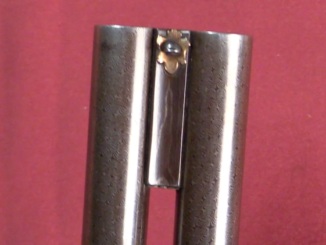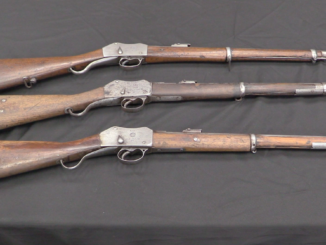Needlefire rifles were developed in the 1830s and represented and early effective type of breechloading rifle. As such, they were adopted by both German and French armies – but only in rifle form. Needlefire handguns were much less common. This particular design was patented in 1852 by a man named G.L. Kufahl in the UK, but ultimately manufactured under license by the Dreyse company. It was available in several configurations of caliber and barrel length, with this one being in .43 caliber.
After this was filmed, I did discover what the powder charge marking on the piece translate to – approximately 11.5 grains of black powder. In addition, the Prussian measurement system they were marked in was only in use until 1871 or 1872, meaning that they give us an end bracket for the date the gun could have been made. Between that and the “v” in Dreyse’s name, it can be narrowed down to between 1864 and 1872.




The revolver was clearly designed for double-action fire at relatively close range. Whether accidentally due to the necessary receiver length for the needle mechanism or by design, the Kufahl has a commendably low boreline for a DA revolver, very like the early model Mateba .38 Special. A fairly well thought out close-quarters defense gun. Very cool looking, too.
Loading is reminiscent of the Thuer. I’m wondering if it could have used a metallic cartridge like the Moore “teat-fire”.
That “drawer-pull” finial at the back confuses me. I see that it moves back a bit and then goes forward as the needle moves. Could it also be used to cock the needle for single-action fire rather like a bolt action?
IIRC, the Dreyse needle rifle had such a setup, single-action only of course, and the needle had to be cocked by hand before the bolt could be opened. Which was one reason the Mauser’s early automatic cock-on-closing was hailed as such a major advance in 1870 or so. One less thing to fiddle with under fire.
cheers
eon
Great thinking, eon. This revolver is quicker than a Colt in terms of ignition time. In a quick draw, the needle-fire would likely get the first shot. But I’m concerned about the buyers, since most would be unfamiliar with a hammerless design. “Oh no, I just shot Meyer in the kidney!”
Had this been converted for metallic cartridges, the only problem would be extraction should a conventional rim-fire round be used. But with a little redesign, that would be amended. Or perhaps this could have a swing-out cylinder, saving the user plenty of time by loading with moon clips or speed loaders.
As mentioned on the Moore revolver article, Europeans were far ahead of Americans in terms of practical arms design in the 19th Century as they were constantly killing each other or killing obviously angry inhabitants of conquered territories. More conflicts meant more motivation to speed up the pace of the arms race. The Mauser brothers became quite popular in the arms industry, didn’t they?
Since most of these revolvers show up with the needle broken off (due to erosion by powder gases and firing heat, which plague the Dreyse system rifles as well), I’m wondering if simply rounding off the broken end of the needle and changing to a bored-through cylinder wouldn’t have resulted in a more conventional centerfire revolver.
The needle gun doesn’t really have to have the primer in the base of the bullet, although it’s more stable there when the “firing pin” gives it a swift kick. The French Chassepot rifle, while nominally a “needle gun”, actually has a firing pin more like a later metallic cartridge rifle because its cartridge had the primer cup at the very back end, rather like a centerfire metallic cartridge. It was still a linen cartridge, though;
http://upload.wikimedia.org/wikipedia/commons/a/ad/Compare_Dreyse-Chassepot.jpg
The Kufahl revolver could have worked very well with a Chassepot-type cartridge and a shorter needle.
The Chassepot rifle’s main problems in service were that (1) its bolt had a rubber sealing gasket which, after a few dozen rounds had been fired, hardened, swelled and cracked so badly due to firing heat that it made it nearly impossible to close the bolt, and (2)the cartridge, being basically a linen round, didn’t react well to excessive force being used to close the bolt, usually being squashed and split open in the process.
It’s noteworthy that, during the Franco-Prussian War, French troops preferred captured Dreyse needle rifles (or even Bavarian Lindner patent outside hammer bolt-actions) to their issued Chassepots. Part of it was no doubt the old “the grass is greener on the other side of the hill” thing, but there was also a recognition that while the Dreyse wasn’t as refined as the Chassepot, and had its own problems, at least it worked most of the time.
cheers
eon
Here’s a link to a forum on Dreyse Needle guns and Chassepots. There are some images of pages from a German publication which includes this pistol. Interestingly there is a diagram of a catridge which matches your suggestion of the rear placement of primer. There’s also a replica of this pistol with the grips off.
http://forums.gunboards.com/showthread.php?47410-Shooting-Dreyse-needle-ignition/page3
Thank you very much. From the “opened up” revolver, I see that the mechanism is a striker-fired type, which of course you’d expect with a needle type gun. And it’s definitely a straight “trigger-cocker”, as there is nothing like a single-action sear notch that I can see.
The separate rammer is very like that seen on some of the British Adams and Tranter percussion revolvers. No moving parts, so one less thing to go wrong. And unlike a Colt, it’s not dead weight on the revolver when not in use. (Of course, it’s a lot more difficult to lose the attached Colt rammer. Everything is tradeoffs.)
The cartridge is interesting, too. It looks like someone was thinking of a Chassepot-type alteration to the rifle or revolver design, which would probably increase the service life of the “firing pin”. I noted the poster who stated that there were only a couple of places that could make the needles properly. The metallurgy must be interesting, to say the least.
cheers
eon
Eon,
The research I’ve seen on the issue indicates the opposite, that the Prussians considered the Dreyse rifle thoroughly inferior to the Chassepot and in fact began using captured French weapons towards the end of the war. Which makes a considerable amount of sense considering that by that point the Dreyse was more than twenty years old and the Chassepot was a brand new design.
One thing I found on that forum was that some people are definitely shooting those rifles or replicas of them. It sounds like they stack plumbers washers for the rubber seal. One mentions that the gas vents safely forwards from the Dreyse and I also read about 3″ groups from them so all up it sounds like they are remarkably good considering all of the theoretical problems. I only wish I could read German!
The use of washers for Chassepots is mentioned on post 27 and post 32 is very much woth reading. It’s where I got the 3″ group from and it corrects/challenges a lot of common beliefs about the Dreyse system. It turns out most of what we’ve read may be wrong!? http://forums.gunboards.com/showthread.php?47410-Shooting-Dreyse-needle-ignition
and on post
Nice work. I acquired an old glass plate negative of a Dreyse Zündnadel revolver a couple of years ago, and I recently made a higher quality scan of it. The version in the photo appears to lack any form of caliber description and has a small extension to the front of the frame.
I heard that they were reproductions of these out in Europe is there anyway I could get my hands on one of these.
This guy in the Czech Republic actually created a 3D printed working model of a Dreyse revolver. There are no schematic available online so he says he used some deductive reasoning to re-create the internal mechanisms. Looks really good, though kinda expensive
https://www.etsy.com/listing/1066266540/dreysekufal-needle-revolver-3d-print?ref=SellerDashboard&fbclid=IwAR0pCQjah0rcWQn2DLqJeh-9FsDbmFWj0P5JZD3g4tEIJeGdl2EdEkzI_hc